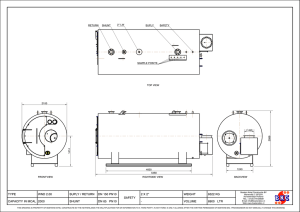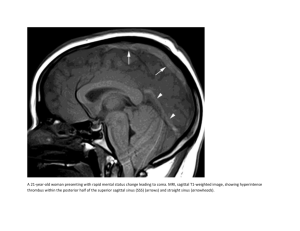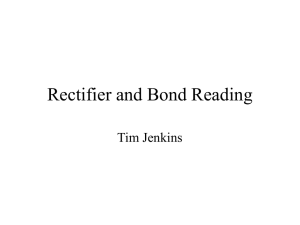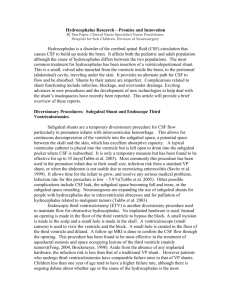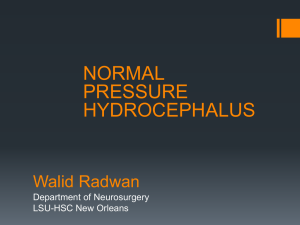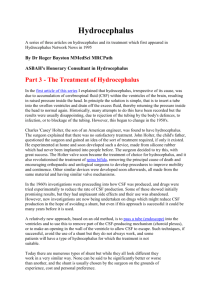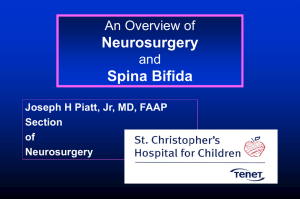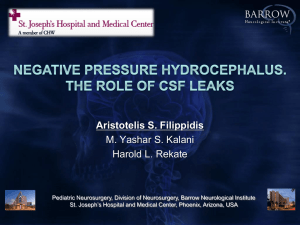vii. Emergency Evaluation of Hydrocephalus and Shunts
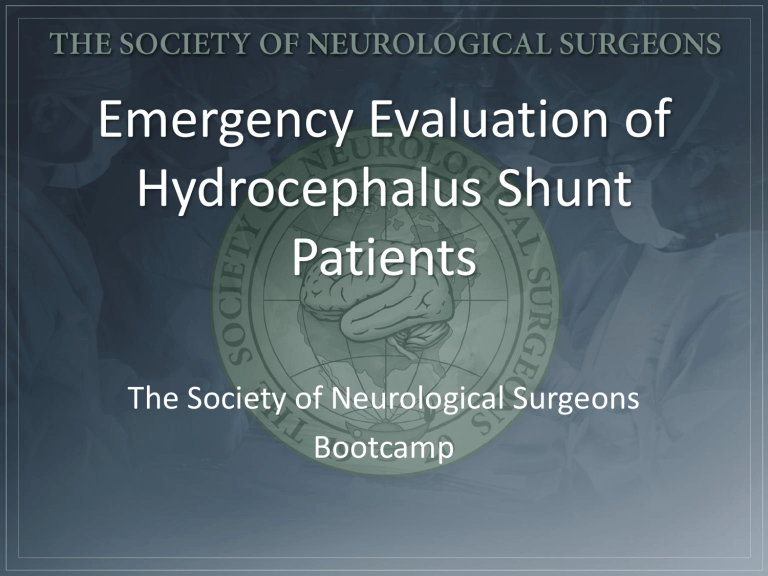
Emergency Evaluation of
Hydrocephalus Shunt
Patients
The Society of Neurological Surgeons
Bootcamp
Communicating vs. Obstructive
Hydrocephalus
• Communicating Hydrocephalus
– All 4 ventricles are enlarged
– Causes: IVH of prematurity (grade III/IV), adult IVH, aneurysmal SAH, meningitis
– May do lumbar puncture
• Obstructive Hydrocephalus
– Dilatation of lateral and third ventricles with small, compressed or normal size 4 th ventricle
– Asymmetry or enlargement of lateral ventricle when obstruction is at
Foramen of Monro ( e.g. colloid cyst)
– Posterior fossa mass lesions (tumor, ICH, cyst), intraventricular mass lesions (tumor, IVH, cyst), aqueductal stenosis
– Do NOT do lumbar puncture
Communicating Hydrocephalus
• Enlargement of lateral, 3 rd , and 4 th ventricles
– Note sulcal effacement, temp horns, rounded 3 rd , and enlarged 4 th
Obstructive Hydrocephalus
• Aqueductal stenosis
– Note enlarged frontal horns, temporal tip dilation, rounded 3 rd but small or normal 4 th ventricle
Shunt Technology
• Pressure differential valves
• Antisiphon valves
• Flow regulated valves
• Programmable valves
OSV
CSF Shunt Malfunction:
Infants
• Progressive macrocephaly
• Tense anterior fontanelle
• Sutural splaying
• Downgaze, lid retraction
• Esotropia (VIth nerve palsy)
CSF Shunt Malfunction:
Children
• Developmental delay
• Decline in school performance (esp. verbal IQ)
• Visual loss
Radiology
• Compare ventricular size to “ well ” baseline
– Infants: Transfontanelle ultrasound
– CT
– MRI
• Shunt x-ray series
– Disconnection or fracture of tubing
Invasive Studies
• CSF shunt tap
– Assess flow and pressure (although proximal obstruction may commonly interfere with accuracy)
– Send CSF for GS/Cx, Glu/Pro, cell counts if infection suspected
– Relieve pressure if obstructed distally
• Radionuclide shuntogram
– Assess proximal and distal flow
– Ventricular reflux and outflow each correlate with appropriate function (but test is imperfect)
• Intracranial pressure monitoring
CSF Shunt Infection
• Organisms
• Staph. Epi (40%)
• Staph. Aureus
(20%)
• Gram Negatives
• Diptheroids
• Yeast
• Therapy
• Externalize shunt
• Change hardware
• Antibiotics
• Consider LP
Differential Diagnosis of Shunt
Infection
• Gastroenteritis
– Often associated with sick contacts, diarrhea
• Otitis
– May often be detected on physical examination
• Urinary tract infection
– Important to differentiate from colonization in spina bifida patients
CSF Shunt Complications:
Mechanical Failure
• Blockage
• Choroid plexus
• Ependyma
• Fracture
• Disconnection
• Valve failure
CSF Shunt Complications:
Mechanical Failure
• Distal failure
• Kinked tubing
• Malabsorption
• Pleural effusion
• Cor pulmonale
• Shunt nephritis
CSF Shunt Complications:
Abdominal failure
• Umbilical hernia
• Extra-peritoneal catheter
• Bowel perforation
CSF Shunt Complications:
Overdrainage
• Postural (Low pressure) headache
• Subdural hygroma
• Craniostenosis
CSF Shunt Complications:
Hemorrhage
• Parenchymal damage
• Raised ICP
• IVH: Valve obstruction
• Ependymal adhesions and multicompartmental hydrocephalus
Shunt Evaluation Protocol:
History
• History
– Hydrocephalus etiology
– Exact date of last tap or revision
– Symptoms of last failure
– Seizure disorder?
– Latex allergy?
• Current Symptoms
– Headache
• Severity/location
• Positional
• Morning
– Mental status changes
– Fever
– Shuntalgia
– Nausea/vomiting
– Intercurrent illness
Shunt Evaluation Protocol:
Diagnostic Studies
• Non-contrast head CT scan (shunt protocol) or ‘ quick brain ’ MRI
• Shunt x-ray series
• Abdominal ultrasound, if indicated
• Shunt tap, if indicated
– Formal skin preparation
– 25g butterfly needle: test OP and valsalva
(OP may be obscured by proximal obstruction)
– CSF sample for GS/Cx, Cell count, Glu/Prot
Shunt Evaluation Protocol:
Admission
• Immediate intervention for:
– Definite, acute malfunction
– Pain
– Infection
– Bradycardia
– Decreased mental and/or vision
• Cardiorespiratory monitoring
• Frequent neurological checks
• NPO except meds
• Anti-microbial shampoo
• Consider steroid prep for latex allergy
Conclusions
• Involve experienced team members in significant care decisions
• When in doubt, keep the patient for observation
• Listen to parents
• Myelomeningocele patients may have protean forms of presentation and increased risk for sudden deterioration
• Remember that, above all, shunt malfunction is a clinical diagnosis, supported by imaging studies and other data
Case 1
• History
– 6 y.o. with post-hemorrhagic hydrocephalus
– 3 days progressive fever and malaise
– Intermittent right sided headaches
– Last revision 3 years ago for obtundation
Case 1
• Physical Examination
– Irritable
– Neurological exam non-focal
– Temperature 102.5 F.
– Inflamed right tympanic membrane with effusion
• Imaging
– Axial imaging: ventricles unchanged from last well scan
– Shunt x-rays without disconnection
• Diagnosis
– Otitis media
– No surgical intervention
• History
– 10 y.o. with myelomeningocele and hydrocephalus
– One week of progressive frontal headaches and neck pain
– One day of vomiting
– Mother states these are typical malfunction symptoms
– Last revision distant
Case 2
• Physical Examination
– Alert
– Baseline
– No papilledema
• Radiology
– Axial imaging unchanged from well baseline (small ventricles)
– Shunt x-rays without disconnection
Case 2
• Diagnosis
– VP shunt malfunction
– Total proximal shunt obstruction was observed at surgery
Case 3
• History
– 10 y.o. brought to E.R. by ambulance, obtunded
– EMT: “ Has a shunt for hydrocephalus; had headaches at home for last few days ”
• Physical Examination
– Unresponsive
– RR 15, labored
– HR 70
– Pupils 4 mm, sluggish
– Frontal valve-reservoir palpable
• Diagnosis
– Severe ventricular shunt malfunction
Case 3
• Treatment
– Neurosurgeon attempts to drain CSF; shunt tap is dry
– 1 gram/kg mannitol is given
• E.R. Course
– Intubated
– During CT, heart rate drops to 40

